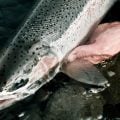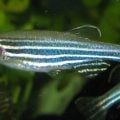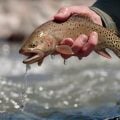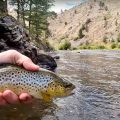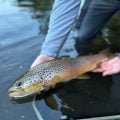Science
The Future of British Brown Trout
In a startling piece over at Hatch Magazine, Chris Hunt details a new study that claims brown trout could disappear from Britain by 2080. At the heart of the study is a model, compiled by scientists, that uses temperature data from the past five years to predict what future temperatures will be. According to this model, "the average daytime water...
Arctic Tundra Now Source of Carbon Dioxide Emissions
According to the National Oceanic and Atmospheric Administration (NOAA), the Arctic tundra is becoming a source of carbon dioxide emissions. NOAA says that the Arctic has stored carbon dioxide in frozen soil for "millennia." As the Arctic tundra burns more frequently during the summer, that frozen soil is melting and releasing that trapped carbon dioxide...
Could You Accidentally Be Killing Steelhead?
Louis Cahill, over at Gink & Gasoline, just wrote up an interesting story about steelhead mortality. Now, his story is anecdotal (the information he shares was shared to him by a friend) but it passes the smell test. It goes like this—is it possible to kill a steelhead without knowing you were the one who dealt the fish its final blow? To understand...
Fish Use Tastebuds to Measure Oxygen
A new study from the University of Ottawa shows that some fish can use their tastebuds to measure oxygen levels in the water. Zebrafish were the species chosen for the study, and as Bernard Rizk writes, the fish literally "can taste oxygen levels in the water using the same cells they use to taste their food. Those same cells also function as oxygen...
Fly Fishing Strengthens Relationship With Wildlife
Although it's more common now than just a few years ago, it's not every day that fly fishing makes headlines in major publications. That is, however, the case with this recent story in YahooUK, by Robin Canniford, Avi Shankar, and Annetta Grant. The authors are also fly anglers and professors at universities in the United Kingdom, and they recently...
New Fish Handling Best Practices
As part of their annual No Fish Dry July initiative, the folks over at Keep Fish Wet (KFW) have released new best practices for handling trout. Of particular note is new research that says the long-held belief that trout fishing should stop at 68 Fahrenheit is incorrect. New research from Jamie Madden, a who has her Master's from Carleton University, worked...
AFF Launches Salmonfly Project on Yellowstone River
The AFFTA Fisheries Fund (AFF) - the conservation arm of the American Fly Fishing Trade Association - recently announced the launch of The Salmonfly Project on the Yellowstone River. The Salmonfly Project is a research initiative that studies the decline of aquatic insects in Western rivers. According to their website, the Salmonfly Project was started by...
Alaska's Orange Rivers
Not long ago, MidCurrent reported on the phenomenon of some Alaskan rivers turning orange. That news has since hit other outlets, renewing interest in this phenomenon, and what it could mean for fly fishing in the Last Frontier. In short, some rivers in Alaska's Brooks Range (a west-east mountain range located above the Arctic Circle) are turning alarming...
Warming Arctic Opens New Salmon Habitat
New research from the University of Alaska Fairbanks shows that recent warm ocean temperatures have spurred higher Pacific salmon abundance in the Canadian Arctic. According to the report, "salmon haven't historically been seen in large numbers in the Arctic Ocean and its watersheds, but in recent years incidental catches by subsistence fishermen have...
Trout Develop Distinct Genes in Mine-Polluted Rivers
A fascinating new study out of the United Kingdom shows that trout living in mine-polluted rivers are genetically different than trout living in clean water. According to an article by the University of Exeter at Phys.org, a recent study conducted at 71 sites in Britain and Ireland shows a distinct genetic difference in brown trout that live in...


